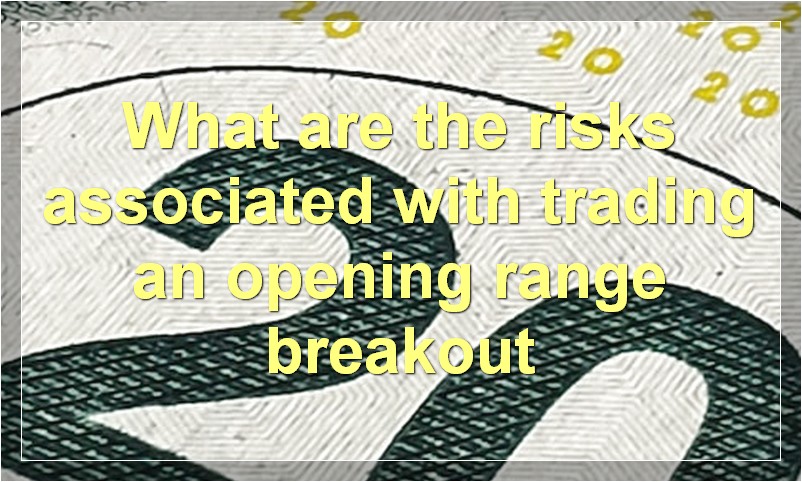Are you interested in trading but don’t know where to start? Look no further than opening range breakout trading. This type of trading is simple and easy to understand, making it perfect for beginners.
What is an opening range breakout
An opening range breakout is a move outside of the high or low of the first period of trading. This move signals a change in direction and momentum, and often leads to continued price movement in the same direction.
Opening range breakouts can occur at any time during the trading day, but are most common at the open. Many traders use opening range breakouts as part of their trading strategy, as they can provide clear and concise entry and exit points.
There are a few things to keep in mind when trading opening range breakouts. First, it’s important to identify the range – which is typically the difference between the high and low of the first hour or so of trading. Second, look for a breakout that occurs with volume – this will help confirm the move. Finally, don’t be afraid to take profits early – oftentimes, once a breakout occurs, there is a quick move in price, so it’s best to take profits while you can.
What are the most common breakout levels for the opening range

The most common breakout levels for the opening range are the 38.2%, 50%, and 61.8% Fibonacci retracement levels. These levels are based on the previous day’s high and low, and they indicate where the market is likely to reverse if the current day’s range is breached. The 38.2% level is considered the strongest, followed by the 50% level, with the 61.8% level being the weakest.
How can you tell if an opening range breakout is likely to succeed
When trading stocks, one of the most popular strategies is to buy after an opening range breakout. An opening range breakout occurs when the stock price breaks out of the range it has been trading in during the pre-market hours. This can be a sign that the stock is about to make a move and that traders are getting bullish on the stock.
There are a few things you can look for to determine if an opening range breakout is likely to succeed. First, you want to look at the volume during the pre-market hours. If there is high volume, it means that there is interest in the stock and that the breakout could have some legs. Second, you want to look at the price action leading up to the breakout. If the stock has been trading in a tight range for several days or weeks, it could be ready to make a move. Finally, you want to look at the news surrounding the stock. If there is positive news or catalysts, it could be enough to push the stock higher.
If you see all of these things lining up, there is a good chance that an opening range breakout will succeed. Of course, there is never any guarantee in the stock market and things can always change quickly. But if you do your homework and pay attention to these key factors, you can give yourself a better chance of success.
What are the best times of day to trade an opening range breakout strategy
If you’re trading an opening range breakout strategy, the best times of day to do so are during the first and last hours of the trading day. This is because there is typically more volume and volatility during these times, which can lead to greater profits.
Why do many traders consider an opening range breakout to be a high-probability setup
An opening range breakout is a high-probability setup because it offers traders a clear and concise way to enter the market. The setup provides traders with a defined risk level, as well as a high potential for reward. The key to success with this setup is to trade it with strict discipline and to always use a stop loss.
What are the risks associated with trading an opening range breakout

When it comes to trading an opening range breakout, there are a few risks that you need to be aware of. First and foremost, you need to make sure that you have a solid plan in place. This means knowing exactly how you’re going to enter and exit the trade, as well as where your stop loss will be placed. Without a plan, it’s very easy to get caught up in the moment and make impulsive decisions that can end up costing you money.
Another risk to be aware of is false breakouts. These occur when the market breaks out of the opening range only to quickly reverse and head back in the other direction. This can often lead to traders chasing the market and getting caught on the wrong side of the move. To avoid this, always use a stop loss when trading an opening range breakout. That way, if the market does reverse, you’ll limit your losses.
Finally, make sure that you manage your risk properly. This means not putting all of your eggs in one basket and diversifying your portfolio. By doing this, you’ll protect yourself from any one particular trade going against you.
By following these tips, you’ll help to reduce the risks associated with trading an opening range breakout. Just remember that even with a solid plan in place, there’s always going to be some element of risk involved. So, don’t risk more than you can afford to lose and always use stop losses to protect your capital.
What are some tips for managing risk when trading an opening range breakout
When trading an opening range breakout, the first thing you need to do is identify the range. This can be done by looking at a price chart and identifying the highest and lowest prices that have been reached in the given time period. Once you have identified the range, you need to set your buy and sell orders accordingly.
There are a few things you need to take into account when setting your orders. Firstly, you need to make sure that your orders are not too close to the current price, as this could result in you getting stopped out of your position prematurely. Secondly, you need to take into account the potential for false breakouts. This is where the price breaks out of the range, but then quickly reverses and goes back into the range. To account for this, you can place your stop loss just outside of the range.
Once you have placed your orders, it is important to manage your risk accordingly. One way to do this is to only risk a small percentage of your total account balance on each trade. This way, even if you do experience a loss, it will not be devastating to your account. Another way to manage risk is to use a trailing stop loss. This is where you move your stop loss up as the price moves in your favor, so that if the price does reverse, you will still be able to exit the trade with a profit.
By following these tips, you can help to minimize your risk when trading an opening range breakout.
What are some common mistakes that traders make when trading an opening range breakout
When trading an opening range breakout, many traders make the mistake of going against the initial price move. They enter their trade in the opposite direction of the breakout, hoping to catch a reversal. However, most of the time, the initial move continues and they end up losing money.
Another common mistake is not using proper risk management. Traders often risk too much on a single trade, hoping to make a big profit. But if the trade doesn’t go their way, they can lose a lot of money. It’s important to always use stop-loss orders and to never risk more than you can afford to lose.
Finally, many traders don’t have patience and they exit their trades too early. They take profits too soon, before the trade has had a chance to really move in their favor. Often times, if they had just held on for a bit longer, they could have made a lot more money.
How can you fine-tune an opening range breakout strategy for better results
If you’re looking to fine-tune your opening range breakout strategy for better results, here are a few tips to keep in mind.
First, be sure to define your parameters clearly. What exactly are you looking for in an ideal breakout setup? What timeframe are you trading on? What kind of risk/reward profile are you comfortable with?
Once you have a clear idea of what you’re looking for, you can start to pay closer attention to market conditions and identify potential breakout opportunities.
When you see a potential breakout setup forming, don’t jump in immediately. Instead, wait for the market to confirm your analysis by breaking out of the defined range before entering a trade.
Finally, once you’re in a trade, don’t forget to manage your risk. Use stop-loss orders to protect your capital, and take profits when the market moves in your favor. By following these simple tips, you can fine-tune your opening range breakout strategy for better results.
Are there any alternative strategies that can be used in lieu of an opening range breakout
There are a few alternative strategies that can be used in lieu of an opening range breakout. One is to wait for a breakout above the high or low of the previous day. Another is to use a trailing stop-loss.

